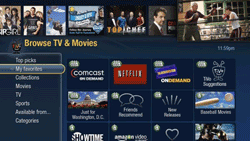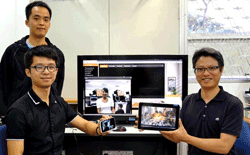Technology lets users “pull” shows off TV and “throw” them onto phones and tablets
Unique solution to watching TV on modern-day devices
Between TVs, computers, tablets, and smartphones, today’s market presents plenty of ways for users to watch entertainment programs. An advancement that’s helped fuel this expansion of modern-day media consumption is on-demand programming, which allows users to watch their show or movie at their convenience.

On-demand programming has helped fuel the popularization of modern-day media devices. (Via: engadget.com)
But on-demand programming is quickly becoming a limited technology in the sense that if a user starts a program on say, a tablet, they’re pretty much stuck watching it on that device until the end; that is, unless they want to re-download the program on a different device and fast forward it to the part where they last left off.
This particular solution is time consuming, and it also doesn’t solve the problem of watching live TV “on-the-go” because there’s always that gap in the program where the user is switching between devices.
Through a unique combination of social media, cloud computing, and digital programming technologies, researchers from the School of Computer Engineering, Nanyang Technological University (NTU) believe they’ve figured out a resolution to this modern-day problem.
Pick up a program and throw it back
Their technology allows users to “pull” an in-progress program on one device and “throw it” onto another, thus allowing the user to continue watching the program seamlessly, without having to re-download it or miss a portion of a live event while switching between devices.
Additionally, the technology allows users to share their program with family and friends, no matter which part of the world they’re in, and discuss the shows too, through their choice of communication technology, whether it’s video chat, voice, or text.
NTU Assistant Professor Wen Yonggang, who worked on this project, describes the invention as the next frontier of television experience, one which allows users to “bring the social experience of watching television in your living room where you go.”
Social Cloud TV
While the idea behind the technology is interesting, the obvious question is: how?
Basically, the system leverages a cloud-based backend for video processing, thus allowing the same video to be streamed into devices in the correct format. In terms of sharing the video, when the program is in progress, users can invite family and friends to join in the private online session from either their phone book or social networking contact lists via sites like Facebook and Twitter.
“You could watch a video with your classmates on the computer, and just before you leave school, ‘pull’ the show into your tablet and continue watching on the go,” said Assistant Professor Wen. “Upon reaching home, you could just turn on your television and ‘throw’ the video back to the TV, and continue watching the program there.”
He adds, “With the increase in online video and personal multimedia devices, we have lost out on the experience of watching TV shows together as a family and as a social activity with friends. So I hope that with my invention, people can now reconnect with each other socially using videos.”
The prototype took a year and a half to develop. Along with Wen, there were nine other members involved, three of which were NTU undergrad students.

Assistant Professor Wen Yonggang (r) with students who helped collaborated on development of the Social Cloud TV technology.
Good timing
According to a 2012 report by Global Industry Analysts Inc., the entertainment industry is set to reach $1.4 trillion (US) by 2015, and Wen’s system is in the unique position of tapping into all facets of the developing technology convergence of the multimedia market, including smartphones, tablets, computers, and television.
That being said, the group’s Social Cloud TV has already attracted the attention of telecommunication companies the world over, the likes of which are specifically interested in integrating the technology into their existing cable networks as a market differentiator for cable television and mobile networks. Discussions are currently underway, and users can expect to see on-the-go capable videos and TV shows in about two years.
In the meantime, to further improve and commercialize the technology, Wen will be setting up a start-up company to seek additional funding, and to further collaborate on projects with industry partners. ■
Story via NTU.edu
Advertisement
Learn more about Electronic Products Magazine





